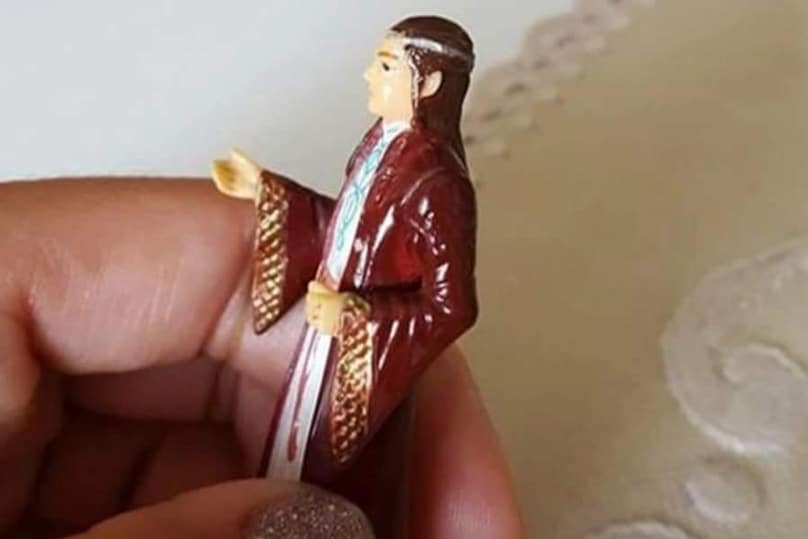
Here is one of those odd stories that makes me wonder how it reached a global news network. Could be true. Could be urban legend for all I know (and I really do wonder how such a story gets from a little old lady’s living room to a global epidemic of comedy, so I take it with a grain of salt).
Seems a little old lady in Brazil mistook an Elrond the High Elven King of Rivendell action figure for a statue of St Anthony for several years and has been using it in her devotions. A respectable mistake for a little old lady and great-grandmother who is not dialled in to pop culture and I’m sure St Anthony didn’t mind and found it adorable.
This is the kind of thing some (not all) Protestants recoil from with equal parts horror and pity while Catholics just chuckle and move on. The reaction of the Protestants is due to a belief that the little old lady literally believes the statue is St Anthony/God/Some Sort of Magical Mojo Wi-fi Device, as well as to the further (quite irrational) belief that since the “true identity” of this piece of plastic is “actually” the fictional Elrond, therefore the little old lady’s devotion to St Anthony is all stuff and nonsense.
But that is, of course, a tangle of illogic and false assumptions. The piece of plastic is a piece of plastic, but more than a piece of plastic. It is a signifier, an image: like a bowling trophy. And to such signifiers people can attach all sorts of different meanings.
Curiously, Protestants who jeer at Catholic use of images as alleged sins against the Second Commandment tend not to have huge moral issues with bowling trophies, even though they too are graven images. Why? Because they are not associated with religiony things like saints and biblical figures and that is what makes them, in the eyes of critics, idols. They symbolise instead some great human achievement by the Big Lebowski at the World O’Pins Lanes in Paducah (Kentucky).
Or an identical trophy honours the prodigy performed by your Aunt Marge in Milsons Point, NSW on that fateful day in November 2001 when she scored a strike at the last minute and saved the Wallaroo Tool and Die Team’s bacon from the hated bullies of the Yankalilla (SA) Machine Shop Team.
Or a third identical statue can honour little Johnny Jones’ heroic effort to get a ball all the way down the lane in the Rollin’ Against Leukaemia Fundraising Tourney in 2011. It may be the most treasured memory of Johnny that his parents have left to them and they may talk to it as they used to talk to Johnny before his death. And what churl would tell them to stop?
That’s the thing about images: we can assign totally different meanings and identities to the same image because the image is about how we engage unseen realities, as well as memories.
Our use of images is about what we believe is and is not okay to engage our senses in seeing. I once visited King’s Chapel in Boston. It is an Anglican/Calvinist church built in the 1700’s by the prosperous burghers and worthies of that noble city. Being Calvinist, the shrine absolutely forbade as Romish poison the use of sacred images of Jesus, the Virgin, or the saints. All that religiony stuff was deemed idolatrous. But then, the prosperous burghers and worthies of Boston wanted it very clearly spelled out to the worshipper just who had paid for King’s Chapel. So the Keepers of the shrines proceeded to fill it to the rafters with tons of statues and busts depicting the rich donors who helped build the joint. Result: a church barren and devoid of a single visible sign of the holy, but brimming with graven images of rich guys.
And there was no mistaking a single solitary one of these images for St Anthony.
The lady in Brazil made an honest mistake. She thought an image most people intended to refer to an imaginary character named Elrond referred to a real saint named Anthony. And because she knew that real saint referred with all his heart, soul, mind, and strength to a God who became an image in Christ Jesus, she asked St Anthony to pray for her as I would ask you to pray for me. That’s not a problem, that’s a sweet, good thing — made just a little sweeter and dearer by a perfectly understandable mistake. God love her for it. On the scale of blunders, I reckon venerating St Anthony via an Elrond action figure is probably less of an error than venerating a bunch of rich businessmen and politicians.
